Ismail Elezi
RetouchLLM: Training-free White-box Image Retouching
Oct 09, 2025Abstract:Image retouching not only enhances visual quality but also serves as a means of expressing personal preferences and emotions. However, existing learning-based approaches require large-scale paired data and operate as black boxes, making the retouching process opaque and limiting their adaptability to handle diverse, user- or image-specific adjustments. In this work, we propose RetouchLLM, a training-free white-box image retouching system, which requires no training data and performs interpretable, code-based retouching directly on high-resolution images. Our framework progressively enhances the image in a manner similar to how humans perform multi-step retouching, allowing exploration of diverse adjustment paths. It comprises of two main modules: a visual critic that identifies differences between the input and reference images, and a code generator that produces executable codes. Experiments demonstrate that our approach generalizes well across diverse retouching styles, while natural language-based user interaction enables interpretable and controllable adjustments tailored to user intent.
Region-based Cluster Discrimination for Visual Representation Learning
Jul 26, 2025Abstract:Learning visual representations is foundational for a broad spectrum of downstream tasks. Although recent vision-language contrastive models, such as CLIP and SigLIP, have achieved impressive zero-shot performance via large-scale vision-language alignment, their reliance on global representations constrains their effectiveness for dense prediction tasks, such as grounding, OCR, and segmentation. To address this gap, we introduce Region-Aware Cluster Discrimination (RICE), a novel method that enhances region-level visual and OCR capabilities. We first construct a billion-scale candidate region dataset and propose a Region Transformer layer to extract rich regional semantics. We further design a unified region cluster discrimination loss that jointly supports object and OCR learning within a single classification framework, enabling efficient and scalable distributed training on large-scale data. Extensive experiments show that RICE consistently outperforms previous methods on tasks, including segmentation, dense detection, and visual perception for Multimodal Large Language Models (MLLMs). The pre-trained models have been released at https://github.com/deepglint/MVT.
"Principal Components" Enable A New Language of Images
Mar 11, 2025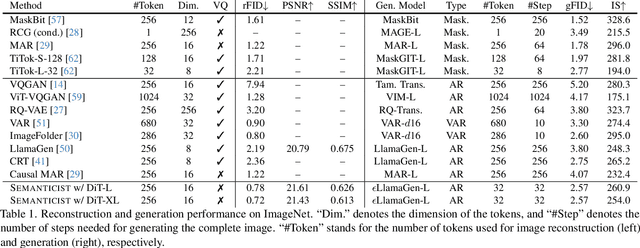

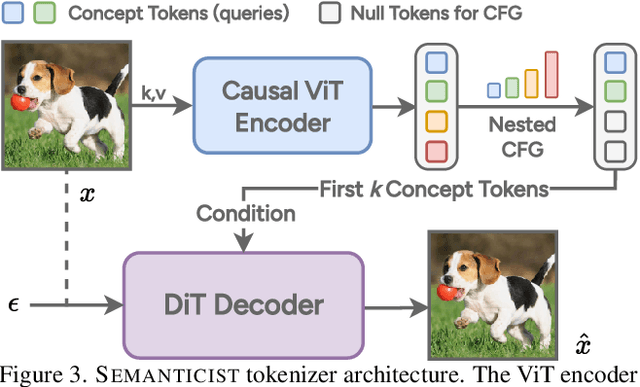
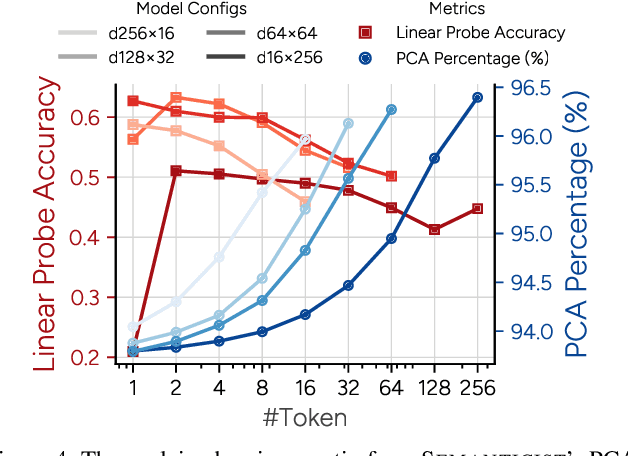
Abstract:We introduce a novel visual tokenization framework that embeds a provable PCA-like structure into the latent token space. While existing visual tokenizers primarily optimize for reconstruction fidelity, they often neglect the structural properties of the latent space -- a critical factor for both interpretability and downstream tasks. Our method generates a 1D causal token sequence for images, where each successive token contributes non-overlapping information with mathematically guaranteed decreasing explained variance, analogous to principal component analysis. This structural constraint ensures the tokenizer extracts the most salient visual features first, with each subsequent token adding diminishing yet complementary information. Additionally, we identified and resolved a semantic-spectrum coupling effect that causes the unwanted entanglement of high-level semantic content and low-level spectral details in the tokens by leveraging a diffusion decoder. Experiments demonstrate that our approach achieves state-of-the-art reconstruction performance and enables better interpretability to align with the human vision system. Moreover, auto-regressive models trained on our token sequences achieve performance comparable to current state-of-the-art methods while requiring fewer tokens for training and inference.
From Attention to Activation: Unravelling the Enigmas of Large Language Models
Oct 22, 2024Abstract:We study two strange phenomena in auto-regressive Transformers: (1) the dominance of the first token in attention heads; (2) the occurrence of large outlier activations in the hidden states. We find that popular large language models, such as Llama attend maximally to the first token in 98% of attention heads, a behaviour we attribute to the softmax function. To mitigate this issue, we propose a reformulation of softmax to softmax-1. Furthermore, we identify adaptive optimisers, e.g. Adam, as the primary contributor to the large outlier activations and introduce OrthoAdam, a novel optimiser that utilises orthogonal matrices to transform gradients, to address this issue. Finally, not only do our methods prevent these phenomena from occurring, but additionally, they enable Transformers to sustain their performance when quantised using basic algorithms, something that standard methods are unable to do. In summary, our methods reduce the attention proportion on the first token from 65% to 3.3%, the activation kurtosis in the hidden states from 1657 to 3.1, and perplexity penalty under 4-bit weight quantisation from 3565 to 0.3.
Fractal Calibration for long-tailed object detection
Oct 15, 2024



Abstract:Real-world datasets follow an imbalanced distribution, which poses significant challenges in rare-category object detection. Recent studies tackle this problem by developing re-weighting and re-sampling methods, that utilise the class frequencies of the dataset. However, these techniques focus solely on the frequency statistics and ignore the distribution of the classes in image space, missing important information. In contrast to them, we propose FRActal CALibration (FRACAL): a novel post-calibration method for long-tailed object detection. FRACAL devises a logit adjustment method that utilises the fractal dimension to estimate how uniformly classes are distributed in image space. During inference, it uses the fractal dimension to inversely downweight the probabilities of uniformly spaced class predictions achieving balance in two axes: between frequent and rare categories, and between uniformly spaced and sparsely spaced classes. FRACAL is a post-processing method and it does not require any training, also it can be combined with many off-the-shelf models such as one-stage sigmoid detectors and two-stage instance segmentation models. FRACAL boosts the rare class performance by up to 8.6% and surpasses all previous methods on LVIS dataset, while showing good generalisation to other datasets such as COCO, V3Det and OpenImages. The code will be released.
VeLoRA: Memory Efficient Training using Rank-1 Sub-Token Projections
May 28, 2024



Abstract:Large language models (LLMs) have recently emerged as powerful tools for tackling many language-processing tasks. Despite their success, training and fine-tuning these models is still far too computationally and memory intensive. In this paper, we identify and characterise the important components needed for effective model convergence using gradient descent. In doing so we find that the intermediate activations used to implement backpropagation can be excessively compressed without incurring any degradation in performance. This result leads us to a cheap and memory-efficient algorithm for both fine-tuning and pre-training LLMs. The proposed algorithm simply divides the tokens up into smaller sub-tokens before projecting them onto a fixed 1-dimensional subspace during the forward pass. These features are then coarsely reconstructed during the backward pass to implement the update rules. We confirm the effectiveness of our algorithm as being complimentary to many state-of-the-art PEFT methods on the VTAB-1k fine-tuning benchmark. Furthermore, we outperform QLoRA for fine-tuning LLaMA and show competitive performance against other memory-efficient pre-training methods on the large-scale C4 dataset.
Deep Active Learning: A Reality Check
Mar 21, 2024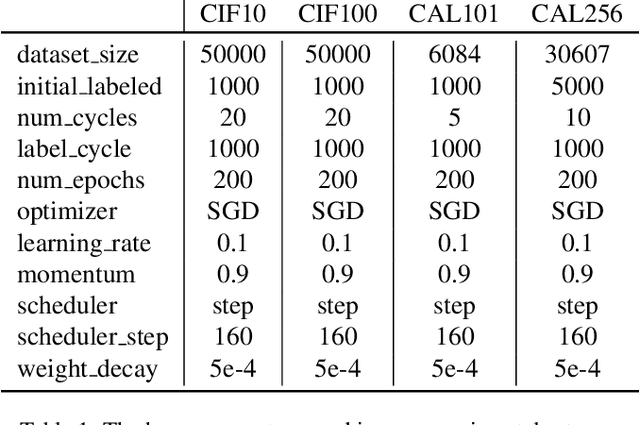
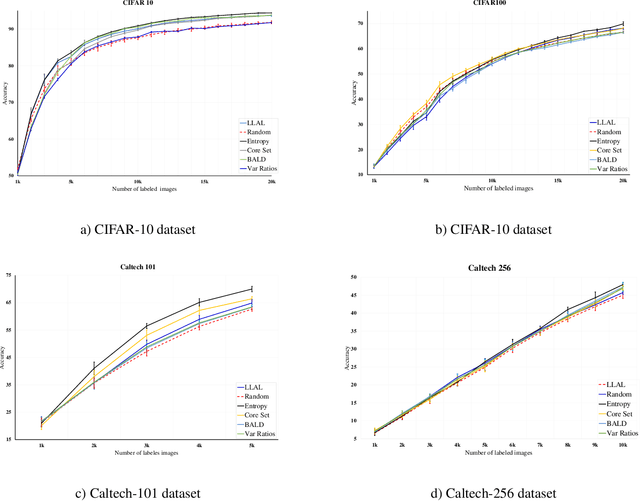
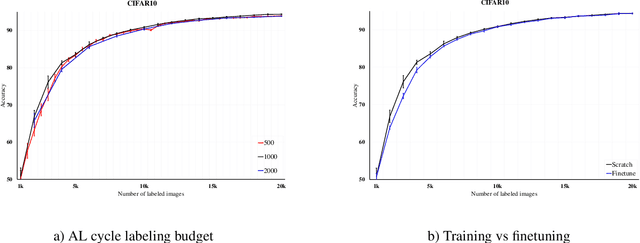
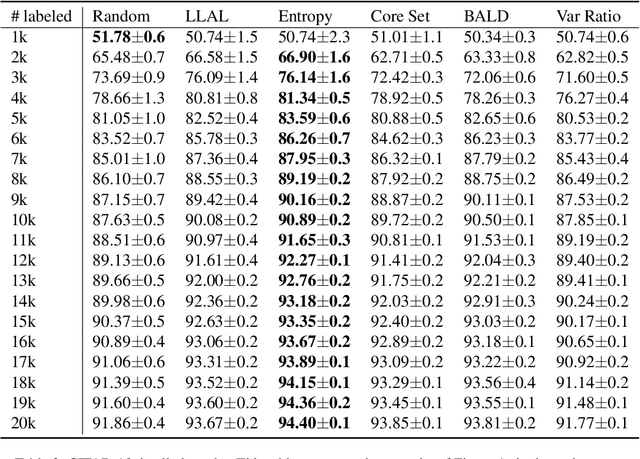
Abstract:We conduct a comprehensive evaluation of state-of-the-art deep active learning methods. Surprisingly, under general settings, no single-model method decisively outperforms entropy-based active learning, and some even fall short of random sampling. We delve into overlooked aspects like starting budget, budget step, and pretraining's impact, revealing their significance in achieving superior results. Additionally, we extend our evaluation to other tasks, exploring the active learning effectiveness in combination with semi-supervised learning, and object detection. Our experiments provide valuable insights and concrete recommendations for future active learning studies. By uncovering the limitations of current methods and understanding the impact of different experimental settings, we aim to inspire more efficient training of deep learning models in real-world scenarios with limited annotation budgets. This work contributes to advancing active learning's efficacy in deep learning and empowers researchers to make informed decisions when applying active learning to their tasks.
$V_kD:$ Improving Knowledge Distillation using Orthogonal Projections
Mar 10, 2024



Abstract:Knowledge distillation is an effective method for training small and efficient deep learning models. However, the efficacy of a single method can degenerate when transferring to other tasks, modalities, or even other architectures. To address this limitation, we propose a novel constrained feature distillation method. This method is derived from a small set of core principles, which results in two emerging components: an orthogonal projection and a task-specific normalisation. Equipped with both of these components, our transformer models can outperform all previous methods on ImageNet and reach up to a 4.4% relative improvement over the previous state-of-the-art methods. To further demonstrate the generality of our method, we apply it to object detection and image generation, whereby we obtain consistent and substantial performance improvements over state-of-the-art. Code and models are publicly available: https://github.com/roymiles/vkd
G3DR: Generative 3D Reconstruction in ImageNet
Mar 08, 2024



Abstract:We introduce a novel 3D generative method, Generative 3D Reconstruction (G3DR) in ImageNet, capable of generating diverse and high-quality 3D objects from single images, addressing the limitations of existing methods. At the heart of our framework is a novel depth regularization technique that enables the generation of scenes with high-geometric fidelity. G3DR also leverages a pretrained language-vision model, such as CLIP, to enable reconstruction in novel views and improve the visual realism of generations. Additionally, G3DR designs a simple but effective sampling procedure to further improve the quality of generations. G3DR offers diverse and efficient 3D asset generation based on class or text conditioning. Despite its simplicity, G3DR is able to beat state-of-theart methods, improving over them by up to 22% in perceptual metrics and 90% in geometry scores, while needing only half of the training time. Code is available at https://github.com/preddy5/G3DR
Three Heads Are Better Than One: Complementary Experts for Long-Tailed Semi-supervised Learning
Dec 25, 2023Abstract:We address the challenging problem of Long-Tailed Semi-Supervised Learning (LTSSL) where labeled data exhibit imbalanced class distribution and unlabeled data follow an unknown distribution. Unlike in balanced SSL, the generated pseudo-labels are skewed towards head classes, intensifying the training bias. Such a phenomenon is even amplified as more unlabeled data will be mislabeled as head classes when the class distribution of labeled and unlabeled datasets are mismatched. To solve this problem, we propose a novel method named ComPlementary Experts (CPE). Specifically, we train multiple experts to model various class distributions, each of them yielding high-quality pseudo-labels within one form of class distribution. Besides, we introduce Classwise Batch Normalization for CPE to avoid performance degradation caused by feature distribution mismatch between head and non-head classes. CPE achieves state-of-the-art performances on CIFAR-10-LT, CIFAR-100-LT, and STL-10-LT dataset benchmarks. For instance, on CIFAR-10-LT, CPE improves test accuracy by over >2.22% compared to baselines. Code is available at https://github.com/machengcheng2016/CPE-LTSSL.
 Add to Chrome
Add to Chrome Add to Firefox
Add to Firefox Add to Edge
Add to Edge